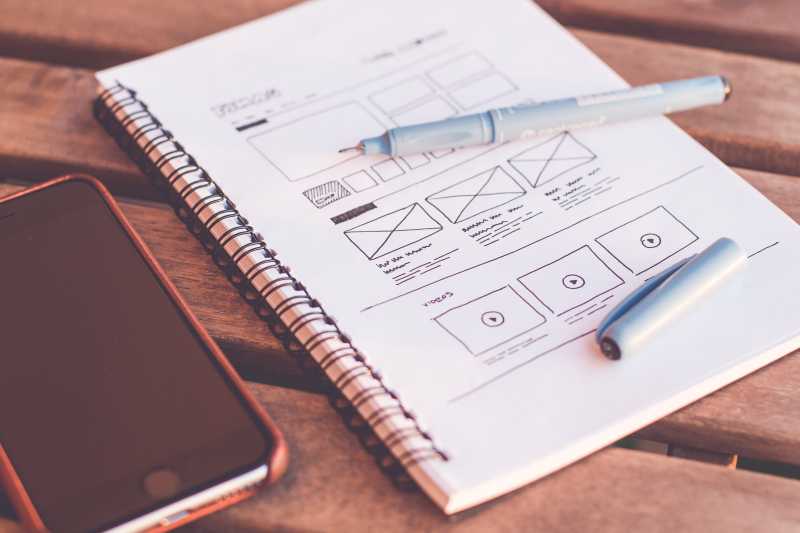In today’s digital age, the importance of a well-designed website cannot be overstated. As a full-service website design and SEO company catering to professionals, small businesses, and corporations, we understand the pivotal role web design plays in improving your business’s conversion rates. A well-structured, user-friendly, and visually appealing website can significantly boost your online presence, attract more visitors, and ultimately convert them into loyal customers. This blog post will delve into the intricate relationship between web design and conversion rates, providing valuable insights on how a strategic design can enhance user experience, increase engagement, and drive business growth. We’ll also touch on the role of SEO in making your website more visible and accessible to your target audience. So, whether you’re a small business owner looking to expand your online reach or a corporate professional seeking to boost your digital marketing efforts, this blog post is a must-read.
Understanding the Importance of Web Design for Business Conversion Rates
In the digital age, the design of your website plays a pivotal role in determining your business’s success. It is not just about creating an aesthetically pleasing layout; it’s about creating a user-friendly environment that facilitates smooth navigation and encourages potential customers to convert.
Web design is a critical component of digital marketing and plays a significant role in enhancing your business’s conversion rates. A well-designed website can significantly increase your business’s conversion rates by improving user experience, building trust, and facilitating the customer journey.
Firstly, a user-friendly website design improves the user experience, which is a crucial factor in conversion rates. A study by Forrester Research found that a well-designed user interface could increase a website’s conversion rate by up to 200%. This is because a user-friendly design makes it easy for visitors to navigate your website, find the information they need, and take the desired action, whether it’s making a purchase, signing up for a newsletter, or filling out a contact form.
Secondly, a professional and aesthetically pleasing web design builds trust with your audience. According to a study by the Stanford Persuasive Technology Lab, 75% of users judge a company’s credibility based on its website design. A well-designed website signals to your audience that your business is professional, reliable, and trustworthy, which can significantly increase your conversion rates.
Lastly, a well-designed website facilitates the customer journey, guiding visitors from the awareness stage to the decision stage. By strategically placing call-to-action buttons, simplifying the checkout process, and providing clear and concise information, you can guide your visitors through the sales funnel and increase your conversion rates.
However, it’s important to note that web design is not a one-size-fits-all solution. What works for one business may not work for another. Therefore, it’s crucial to understand your audience, their needs, and their online behavior. By doing so, you can create a web design that resonates with your audience and drives conversions.
For more information on how web design can improve your business’s conversion rates, check out our blog. If you’re interested in improving your website design to boost your conversion rates, feel free to contact us. Our team of experienced web designers and digital marketers can help you create a website that not only looks good but also drives conversions.
In conclusion, web design plays a crucial role in improving your business’s conversion rates. By creating a user-friendly design, building trust with your audience, and facilitating the customer journey, you can significantly increase your conversion rates and grow your business.
- Forrester Research: “A well-designed user interface can increase a website’s conversion rate by up to 200%.”
- Stanford Persuasive Technology Lab: “75% of users judge a company’s credibility based on its website design.”
Sources:
Forrester Research. (n.d.). The Impact of Interface Design on User Engagement. Retrieved from https://www.forrester.com/
Stanford Persuasive Technology Lab. (n.d.). How Do Users Evaluate the Credibility of Websites? Retrieved from https://credibility.stanford.edu/
Key Elements of Web Design that Boost Conversion Rates
In the digital era, the design of your website plays a pivotal role in improving your business’s conversion rates. A well-designed website not only attracts visitors but also encourages them to engage with your content, ultimately leading them to become customers. There are several key elements of web design that can significantly boost conversion rates.
Firstly, a user-friendly interface is crucial. This includes easy navigation, intuitive layout, and clear call-to-action buttons. Visitors should be able to find what they’re looking for without any hassle. A complicated or confusing interface can deter potential customers, leading to a decrease in conversion rates. To ensure a user-friendly interface, consider hiring a professional web designer or a digital marketing agency that specializes in web design.
Secondly, the visual appeal of your website can greatly influence conversion rates. Aesthetically pleasing design elements such as color schemes, typography, and images can capture visitors’ attention and make your website stand out from the competition. Moreover, a visually appealing website can enhance your brand image and credibility, which can in turn increase conversion rates.
Thirdly, the loading speed of your website is another key element. In today’s fast-paced world, visitors expect websites to load quickly. If your website takes too long to load, visitors may leave and never return, resulting in lost potential customers. Therefore, optimizing your website’s loading speed is essential for boosting conversion rates. This can be achieved through various methods such as compressing images, minimizing CSS and JavaScript, and using a reliable web hosting service.
Furthermore, your website should be mobile-friendly. With the increasing use of smartphones and tablets, more and more people are browsing the web on their mobile devices. A website that is not mobile-friendly can frustrate mobile users and drive them away. On the other hand, a mobile-friendly website can attract a larger audience and increase conversion rates.
Lastly, your website should provide valuable and relevant content. This can help establish your business as an authority in your industry, build trust with visitors, and encourage them to take action. Whether it’s informative blog posts, engaging videos, or helpful guides, providing high-quality content can significantly boost conversion rates.
In conclusion, the design of your website plays a crucial role in improving your business’s conversion rates. By focusing on user-friendly interface, visual appeal, loading speed, mobile-friendliness, and valuable content, you can create a website that not only attracts visitors but also converts them into customers. For more information on how to improve your website’s design and boost conversion rates, feel free to contact us or visit our blog.
How User-Friendly Web Design Enhances Customer Experience and Conversions
In the digital age, the significance of a well-designed website for businesses cannot be overstated. It serves as the virtual storefront, the first point of contact for potential customers. A well-structured, aesthetically pleasing, and user-friendly website can significantly enhance the customer experience, leading to higher conversion rates.
The concept of user-friendly web design revolves around creating a website that is easy to navigate, visually appealing, and intuitive. It’s about making the user’s journey as seamless and enjoyable as possible. This involves a variety of elements, from the layout and color scheme to the navigation menu and the placement of call-to-action buttons.
A user-friendly website design starts with a clear and intuitive navigation. This means that the website’s structure should be easy to understand, with a clear hierarchy and easily identifiable sections. A user should be able to find the information they’re looking for without having to click through multiple pages or search extensively. This can be achieved by using clear labels for navigation menus, having a search bar, and ensuring that the most important information is prominently displayed.
The visual appeal of a website also plays a crucial role in enhancing the user experience. A clean, modern design with a consistent color scheme and high-quality images can make a website more attractive and inviting. This not only improves the user’s perception of the brand but also encourages them to stay on the website longer, increasing the chances of conversion.
Moreover, a user-friendly website design should also be responsive, meaning it should display correctly on all devices, whether it’s a desktop, laptop, tablet, or smartphone. With more and more people using mobile devices to access the internet, having a responsive design is no longer optional but a necessity.
User-friendly web design also involves making the website accessible to all users, including those with disabilities. This can be achieved by following the Web Content Accessibility Guidelines (WCAG), which include providing text alternatives for non-text content, making the website navigable through keyboard, and ensuring that the website can be used without a mouse.
The benefits of a user-friendly web design extend beyond enhancing the user experience. It also has a direct impact on the business’s conversion rates. A website that is easy to navigate and visually appealing is more likely to engage users, keep them on the site longer, and encourage them to take the desired action, whether it’s making a purchase, signing up for a newsletter, or filling out a contact form.
In addition, a user-friendly website design can also improve the website’s search engine optimization (SEO) performance. Search engines like Google favor websites that provide a good user experience, which includes factors like website speed, mobile-friendliness, and easy navigation.
At Cyticx, we understand the importance of user-friendly web design in enhancing the customer experience and improving conversion rates. Our team of experienced web designers and developers work closely with our clients to create websites that are not only visually appealing but also easy to use and navigate.
To learn more about how we can help improve your business’s conversion rates through user-friendly web design, contact us today. You can also check out our blog for more tips and insights on web design and digital marketing.
The Role of Responsive Design in Increasing Conversion Rates
In the digital era, the design of your website plays a critical role in determining the success of your business. One of the key aspects of web design that significantly impacts your business’s conversion rates is responsive design.
Responsive design refers to the approach where a website’s design and development respond to the user’s behavior and environment based on screen size, platform, and orientation. This approach involves a mix of flexible grids and layouts, images, and an intelligent use of CSS media queries. When the user switches from their laptop to an iPad, for instance, the website should automatically switch to accommodate for resolution, image size, and scripting abilities. In other words, the website should have the technology to automatically respond to the user’s preferences.
The importance of responsive design in increasing conversion rates cannot be overstated. In today’s fast-paced world, users expect a seamless online experience, regardless of the device they are using. If a website fails to deliver this, users are likely to abandon it and move on to the competition. This is where responsive design comes in. By ensuring that your website looks and functions perfectly on all devices, you can significantly improve user experience, thereby increasing the likelihood of conversions.
Moreover, responsive design can also help improve your website’s search engine rankings. Search engines like Google prioritize websites that are mobile-friendly in their search results. By implementing responsive design, you can ensure that your website ranks higher in search results, thereby increasing its visibility and attracting more potential customers.
There are several ways in which you can implement responsive design to increase your conversion rates. First, you need to ensure that your website’s layout is flexible. This means that it should be able to adapt to different screen sizes and orientations. You can do this by using flexible grids and layouts.
Second, you need to ensure that your website’s images are flexible. This means that they should be able to scale and resize depending on the screen size. You can do this by using CSS media queries.
Third, you need to ensure that your website’s navigation is user-friendly. This means that users should be able to easily navigate your website, regardless of the device they are using. You can do this by using drop-down menus and collapsible navigation bars.
To learn more about how you can implement responsive design to increase your conversion rates, you can visit our blog. If you need professional help, our team of experienced web designers at Cyticx is always ready to assist you. You can contact us to discuss your needs and how we can help you achieve your business goals.
In conclusion, responsive design plays a crucial role in increasing conversion rates. By ensuring that your website is user-friendly and looks great on all devices, you can improve user experience, increase your website’s visibility, and ultimately, boost your conversion rates.
Case Studies: Successful Web Designs that Improved Conversion Rates
In the digital age, the importance of a well-designed website for any business cannot be overstated. It is the first point of contact for potential customers and can significantly influence their decision to engage with your business. A well-crafted website can enhance user experience, build brand credibility, and ultimately, improve conversion rates.
One of the most effective ways to understand the impact of web design on conversion rates is by examining real-world examples. These case studies provide valuable insights into how businesses have successfully leveraged web design to boost their conversion rates.
The first case study is about a renowned e-commerce platform that saw a significant increase in their conversion rates after revamping their website design. The company decided to simplify their website layout, making it more user-friendly and easy to navigate. They also focused on enhancing the visual appeal of their website by using high-quality images and engaging content. The result was a 30% increase in their conversion rates within a few months of implementing the new design. This case study clearly demonstrates the power of a well-designed website in driving conversions.
The second case study involves a B2B company that offers software solutions. They noticed that their website was not generating enough leads, despite having a significant amount of traffic. After analyzing their website, they realized that it lacked clear call-to-action (CTA) buttons and the overall design was not engaging enough. They decided to redesign their website, focusing on creating a clean, professional look with clear CTAs. The result was a 50% increase in their conversion rates. This case study highlights the importance of having clear CTAs and an engaging design to improve conversion rates.
The third case study is about a non-profit organization that wanted to increase donations through their website. They decided to redesign their website, focusing on creating a more emotional connection with their audience. They used compelling stories, high-quality images, and a simple donation process to achieve this. The result was a 60% increase in their conversion rates. This case study shows how a well-designed website can not only improve conversion rates but also create a deeper connection with the audience.
These case studies provide valuable insights into how businesses can leverage web design to improve their conversion rates. However, it’s important to remember that what works for one business may not necessarily work for another. Therefore, it’s crucial to understand your audience and their needs before implementing any changes to your website design.
If you’re looking to improve your business’s conversion rates through web design, our team at Cyticx can help. We have a team of experienced web designers who understand the importance of creating a website that not only looks good but also drives conversions. We also offer a range of other digital marketing services to help your business succeed online.
For more information, feel free to contact us or visit our blog for more tips and advice on improving your business’s online presence.
Tips and Strategies for Optimizing Your Web Design for Better Conversions
Web design plays a pivotal role in the success of any online business. It’s not just about creating an aesthetically pleasing site; it’s about designing a platform that encourages visitors to engage with your content and ultimately convert into customers. This process, known as conversion rate optimization (CRO), is a critical component of digital marketing and can significantly boost your business’s profitability.
The first step in optimizing your web design for better conversions is understanding your audience. Knowing who your customers are, what they want, and how they interact with your site can provide valuable insights that can guide your design decisions. For instance, if your target audience is older, you might want to use larger fonts and more straightforward navigation. On the other hand, if your audience is younger, you might want to incorporate more interactive elements and dynamic content.
Another crucial aspect of web design for conversions is the user experience (UX). A well-designed site should be easy to navigate, with clear calls to action (CTAs) and a straightforward checkout process. It should also load quickly, as slow-loading sites can frustrate users and lead to high bounce rates. You can learn more about the importance of UX in our blog.
Your site’s content also plays a significant role in conversions. High-quality, relevant content can engage your audience, build trust, and encourage them to take action. This includes not only your written content but also images, videos, and other multimedia elements. You can use A/B testing to experiment with different types of content and see what resonates most with your audience.
Mobile optimization is another key factor in web design for conversions. With more and more people using their smartphones to browse the web, it’s essential that your site is mobile-friendly. This means ensuring that your site looks good and functions well on smaller screens, and that it loads quickly on mobile devices. You can learn more about mobile optimization on our marketing page.
Finally, don’t forget about SEO. While it’s not directly related to conversions, SEO can help increase your site’s visibility in search engine results, which can lead to more traffic and, ultimately, more conversions. You can learn more about SEO strategies on our about page.
In conclusion, optimizing your web design for better conversions involves understanding your audience, improving the user experience, creating high-quality content, optimizing for mobile, and leveraging SEO. By implementing these strategies, you can create a site that not only looks good but also drives conversions and helps grow your business.
Measuring the Impact of Web Design on Your Business Conversion Rates
In the digital age, the importance of a well-designed website for any business cannot be overstated. A website serves as the digital storefront of your business, and just like a physical store, its design can significantly influence your customers’ behavior. This influence extends to your business’s conversion rates, which is the percentage of visitors who complete a desired action on your site, such as making a purchase or filling out a form.
The design of your website can either facilitate or hinder these actions, thereby directly impacting your conversion rates. For instance, a website that is visually appealing, easy to navigate, and quick to load is more likely to retain visitors and encourage them to engage with your content. On the other hand, a poorly designed website can frustrate visitors and prompt them to leave, resulting in lost potential conversions.
To understand how your website’s design is affecting your conversion rates, it’s crucial to measure its impact. This involves analyzing various design elements and their correlation with user behavior. For example, you might examine how the layout of your site affects the user journey, or how the color scheme influences the visibility of your call-to-action buttons. By identifying which elements are contributing to or detracting from your conversion rates, you can make informed decisions about how to improve your website design.
One effective way to measure the impact of your web design is through A/B testing. This involves creating two versions of a web page with different design elements, then comparing their performance in terms of conversion rates. By analyzing the results, you can determine which design elements are most effective in driving conversions.
Another useful tool is heat mapping, which visually represents how users interact with your website. Heat maps can show you where users are clicking, how far they are scrolling, and what areas of your site they are ignoring. This can provide valuable insights into how your web design is influencing user behavior and conversion rates.
In addition to these methods, there are numerous analytics tools available that can help you track and analyze your website’s performance. These tools can provide detailed data on various metrics, such as bounce rate, time on site, and conversion rate, allowing you to assess the effectiveness of your web design.
Once you have measured the impact of your web design on your conversion rates, you can use this information to make strategic improvements. This might involve tweaking your layout, changing your color scheme, or redesigning your call-to-action buttons. By continually testing and refining your web design, you can optimize your site for conversions and boost your business’s bottom line.
In conclusion, web design plays a pivotal role in improving your business’s conversion rates. By measuring its impact and making data-driven design decisions, you can create a website that not only attracts visitors but also converts them into customers. For more information on how to optimize your web design for conversions, feel free to contact us or visit our about page to learn more about our services.
In conclusion, the role of web design in improving your business’s conversion rates cannot be overstated. A well-designed website not only attracts visitors but also encourages them to stay longer, explore your offerings, and ultimately make a purchase. It is a crucial tool in creating a positive user experience, building your brand’s credibility, and fostering customer trust. Therefore, investing in professional web design is not an expense, but a strategic move to boost your conversion rates and overall business growth. Remember, your website is often the first point of contact potential customers have with your brand, so make it count.






